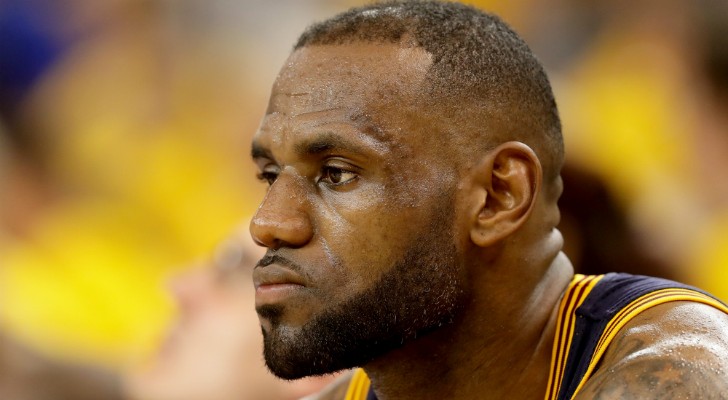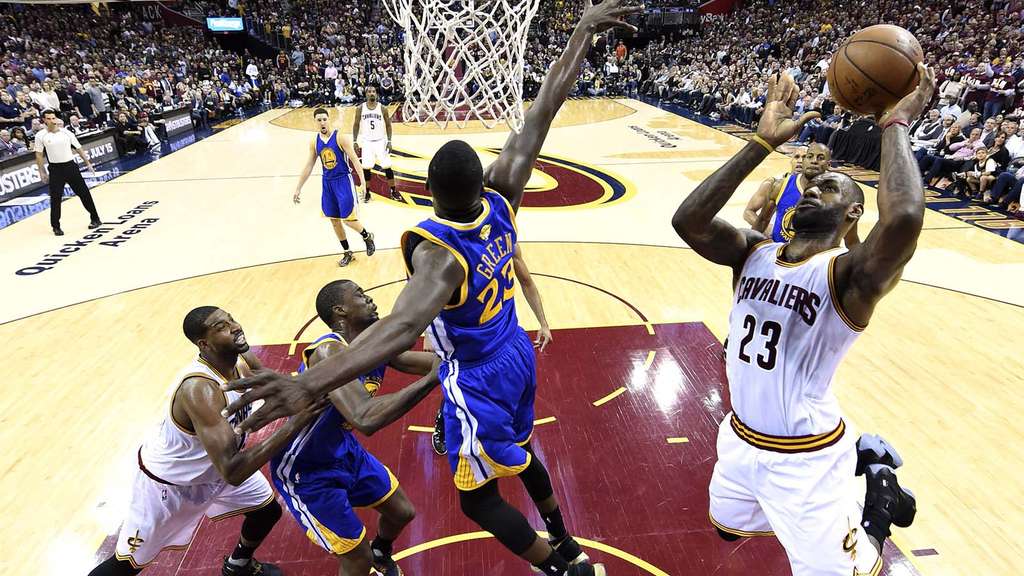What happened? Down 3-1 at a time when we were even last year. Stacked but still struggling to score. Healthy but still falling behind on defense. The Cavs are failing to set themselves apart like 28 other teams, and it’s painful to watch after just four games. For LeBron, a legacy stands at crossroads between four losses in six consecutive attempts or fulfilling a promise. Dramatic, sure; but everyone takes it personally.
As the city’s greatest athlete since the founding of Cleveland State University, LeBron has built a legacy in Ohio alongside one which the World writes for him. His story is a prodigal one, but the “chosen one” isn’t called the King because it’s a catchy, royal nickname. He’s called to rise to any occasion and lift his kingdom along the way. When he falls, his kingdom and its villeins fall harder. In truth, everyone in Cleveland thinks they have a personal relationship with LeBron James. I know I do.
That LeBron James appears to be missing in late grind-out situations these NBA Finals, with multiple games left in the balance for the Cavs after trading blowouts in Games Two and Three. Game One’s fourth quarter malfunction was evocative of the dark overtime Game One loss in last year’s NBA Finals. Game Four featured 15 lead changes before another late collapse with countless defensive breakdowns and just five second-half shot attempts by Cavaliers not named Kyrie Irving or LeBron James. Every analyst has taken note and every fan has taken offense.
When a fan says, “it’s the finals now, and LeBron is playing like it’s his first finals ever!” you have to actually give that idiot the benefit of the doubt. Is LeBron inside his own head?
Granted, he has tied the unfortunate record for highest turnover average in the NBA Finals, a record he set in his first chip-trip in 2007. In Game One’s fourth quarter, he went scoreless for five minutes on just five attempts. His Game Four last stand to avoid a fatal 3-1 hole against the record-blazing Warriors was another five-shot effort. Irving attempted twice as many shots in that fourth quarter in Game Four. Forget what happened to the Cavs – where is the King?

Getty
Since everything has to be compared to last year for some reason, averaging 24.8 points is underwhelming for saying the least as it’s James lowest Finals scoring average since 2011. The intangibles are all there, showing more versatility than anyone in this five-way All-Star matchup with 11.0 rebounds, 8.3 assists, and 2.3 steals. Despite falling just a single assist short of a triple-double twice this series, anxious fans have lost faith in that table-turning LeBron in the playoffs albeit the deserving Warriors performance.
The difference for Cleveland against Golden State has been in its attack. Not just offensively, but feeding off both sides of the floor in hopes of taming some of the most versatile players any franchise has ever put together. Looking to the last four rounds played, back to 2015 Finals, LeBron’s mentality at the point of attack has seemingly lost coherence in this rematch.
Just like last year’s approach against Golden State, LeBron has set eyes on enthroning the paint. Already a team-high of 9.7 drives/game this year before the Finals, James matched his penetrative effort in last year’s championship with 17 drives/game, per NBA.com/Stats. Yet, the most elusive critics cite him for “going in and thinking pass.”
What makes LeBron’s latest criticism even more confounding is that he opts to to pass 29.9% on drives these finals, slightly less than the past three rounds (33.7%) and last year’s Finals (30.1%). The greater issue with the Cavs freight train offense are the results compared to last season’s efficiency. With the same portion of drive-and-kicks, the percentage of shots assisted has dipped to a point where one out of every five of drive-and-kicks is an assist, also per NBA.com/Stats. There’s a five-sided die that has led to glorious, difficult, dangerous, strenuous and random plays off LeBron drives.

Ronald Martinez | Getty
For perspective, designated drive-and-kickers such as Draymond Green and Harrison Barnes have suited their role with every pass off penetration has led to an assist this series. Steph Curry, the league leader in paint FG% for point guards, also commits to 30% passing on drives gets one assist for every four kicks to Golden State’s perimeter hockey team. Kyrie’s point guard impurities have forced LeBron to take a Curry-like facilitative role, obviously; but James is simply abandoning his freedom to control the game flow being the floor general puppet.
Certainly, he needs active and engaged teammates who are working to create off the ball. Credit the Warriors, who have played defense equally, if not exceeding their offensive level of execution. LeBron had to pick up this role last year, but he’s not nearly as focused on his personal box score. Cleveland’s leader can’t go into the final minute of Game Four with less than twenty points given the magnitude of falling behind 3-1. That shows either a personal shooting problem or not taking enough personal possessions. Shooting over 53%, a 12% upswing from last year’s offensive explosion suggests the latter.
In this play, James anticipates the Warriors helping while he drives against the smaller Klay Thompson, purposely crashing the defense to find Matthew Dellavedova ready to make a play. Seeing mismatches break a defense create opportunities for others is where James has his best point guard moments. In moments when his divine ability is called upon
Expecting a double-digit number of drives from James every game, the Warriors have prepared to throw a number of defenses to disrupt his decision making. Without Draymond Green in Game Five, James can reestablish some lost confidence in finishing down low. It’s an unstoppable force meeting an immovable object down low Cavs Nation’s Tomer Azarly finds:
“According to NBA.com/stats, his defense gets better as his opponents get closer to the basket. While the Cavalier he’s defending shoots an average of 58.7% inside of 10 feet, he’s holding them to just 44.9%. Inside of six feet, they shoot an average of 63.3% and Green is holding them to just 46.2%.”
A lot of times James bails out Draymond with driving untimely, often times dribbling into the Warriors hands. Golden State has mastered rotations on a San Antonio level, so they know how resilient their defense is, how much time they can hold something off, and they continue to test those limits. Take this play for instance:
This is typically what we see when LeBron is neutralized, even temporarily. With just six seconds on the shot clock, James decides to drive right into the Golden State rotation which understands it capacity to hold off an open shot once the initial kick is dished and moved around. Perhaps driving left, going baseline away from the rotation, abandoning the pass with the full intention of scoring, might’ve led to a better play. Here, iso situations are ideal, betting on the best player in the World’s first step to beat one person in hopes of viable play at the basket.
With Draymond in the game but strung out by Kevin Love, James recognizes the time to not be a point guard. He makes his move with an ease reminiscent of last year’s aggressiveness.
Many have forgotten his superior basketball IQ, and while Golden State’s team average IQ appears higher than Cleveland, LeBron has the ability to orchestrate a simple and unstoppable game plan when allowed to make point forward decisions.
These decisions give LeBron different priorities than the point guard position he signed for, which now different than last year’s when Dellavedova ran a larger facilitative role than Irving’s score-first floor general tactic this year. Last year, James had a series-low 3.0% turnover tendency on drives. This year taking up Irving and Delly’s role, he’s turning the ball over five times as often on drives.
If James focuses his play-making from the Forward position, similar to how he moved down to the Four with Miami in 2012, then Kyrie can take a perimeter responsibility to run the offense with more of the high screen and rolls while James takes more weak side isolations. Both produce points and passing lanes for role players. More importantly, it gives James a clearer approach to take over. The King needs his 30, an arbitrary number that symbolizes his primary commitment to score and pass off his scoring ability from a forward perspective, not a point guard. Even after 72 wins in 1996, Jordan always needed his 30 in the finals.
Game 5 is always a good time.
